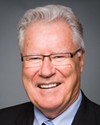Again, first and foremost, I think it's probably getting the resources to fund that type of system. I don't see any problems once it's up and running. You'll need to maintain that system.
It's one of those things you hear about in terms of win-win-win, because once you have.... If we're talking about a district system in a small community, you're saving taxpayers money over the long term in terms of the operating and maintenance costs going down. You're also likely, as we've talked about briefly here, either transferring jobs or creating new jobs to maintain that system. The economic aspects and the financial aspects of the community are positive in most cases, so long as you can see why you need to invest in them.
I used to work for a city. One of the challenges we always had was, “We should maybe do some energy efficiency”, and it was, “Well, how much is that going to cost us?” Well, it's not about a cost; it's about an investment. It's not about the next four years; it's about the long term. If we can plan and then implement in that fashion, the benefits are substantial from an economic, a social, and a financial standpoint.




